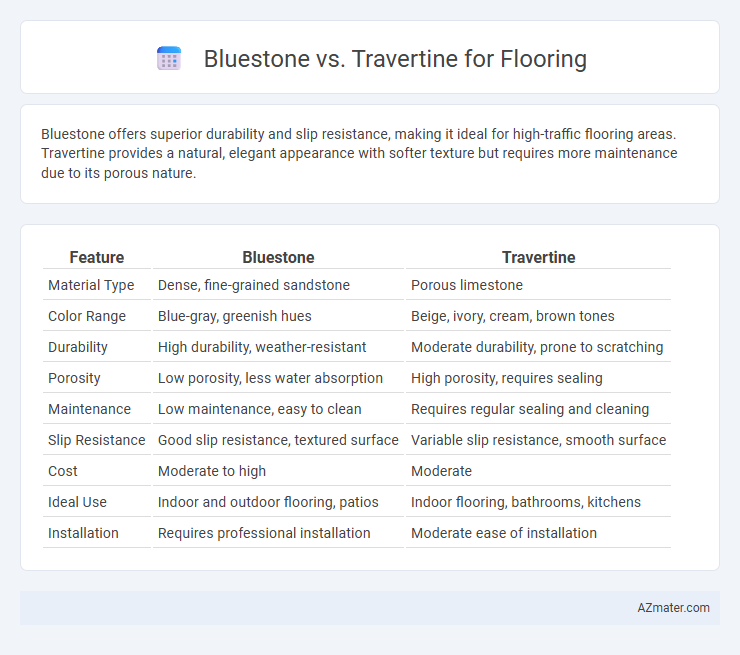Bluestone offers superior durability and slip resistance, making it ideal for high-traffic flooring areas. Travertine provides a natural, elegant appearance with softer texture but requires more maintenance due to its porous nature.
Table of Comparison
| Feature | Bluestone | Travertine |
|---|---|---|
| Material Type | Dense, fine-grained sandstone | Porous limestone |
| Color Range | Blue-gray, greenish hues | Beige, ivory, cream, brown tones |
| Durability | High durability, weather-resistant | Moderate durability, prone to scratching |
| Porosity | Low porosity, less water absorption | High porosity, requires sealing |
| Maintenance | Low maintenance, easy to clean | Requires regular sealing and cleaning |
| Slip Resistance | Good slip resistance, textured surface | Variable slip resistance, smooth surface |
| Cost | Moderate to high | Moderate |
| Ideal Use | Indoor and outdoor flooring, patios | Indoor flooring, bathrooms, kitchens |
| Installation | Requires professional installation | Moderate ease of installation |
Introduction to Bluestone and Travertine Flooring
Bluestone flooring, known for its durability and natural blue-gray hues, originates from dense sandstone formations primarily found in the northeastern United States. Travertine flooring, composed of limestone deposited by mineral springs, showcases unique, porous textures with warm earthy tones ranging from beige to rusty red. Both materials offer distinctive aesthetic appeal and varying levels of maintenance requirements, making them popular choices for both indoor and outdoor flooring applications.
Key Differences Between Bluestone and Travertine
Bluestone features a dense, fine-grained texture with a blue-grey to greenish hue, making it highly durable and slip-resistant, ideal for outdoor flooring applications. Travertine, characterized by its porous surface and warm beige to cream tones, offers a softer, more natural look but requires sealing to prevent staining and wear, commonly used in indoor spaces. The key differences lie in bluestone's hardness and low porosity versus travertine's softness and high porosity, influencing maintenance, appearance, and suitability for different flooring environments.
Appearance and Color Variations
Bluestone offers a range of blue-gray tones with subtle green and brown undertones, creating a cool, contemporary look ideal for modern flooring designs. Travertine features earthier shades such as beige, cream, and rusty reds, providing a warm, natural aesthetic with distinctive pitted textures that enhance its rustic charm. The color variations in Bluestone tend to be more uniform and muted, while Travertine showcases more pronounced veining and variation, making each tile uniquely patterned.
Durability and Longevity
Bluestone offers superior durability due to its dense composition, making it highly resistant to chipping and cracking compared to travertine. Travertine, while aesthetically pleasing with its natural pits and holes, requires regular sealing to maintain longevity and prevent wear. For flooring in high-traffic areas, bluestone provides a longer-lasting, low-maintenance option, whereas travertine may show signs of aging more quickly without proper care.
Slip Resistance and Safety Features
Bluestone offers superior slip resistance due to its naturally textured surface, making it an excellent choice for flooring in areas prone to moisture. Travertine, while aesthetically appealing with its smooth and porous texture, often requires sealing and anti-slip treatments to enhance safety, especially in wet environments. When prioritizing safety features, Bluestone's durability and non-slip characteristics generally outperform Travertine, reducing the risk of falls and improving overall floor stability.
Maintenance Requirements
Bluestone flooring demands regular sealing and prompt cleaning to prevent staining and damage from moisture, while travertine requires even more frequent sealing due to its porous nature, which makes it susceptible to etching and discoloration. Both materials benefit from using pH-neutral cleaners to maintain surface integrity and avoid dulling the finish. Compared to bluestone, travertine's maintenance involves more intensive effort to preserve its aesthetic appeal and prevent deterioration over time.
Installation Process and Costs
Bluestone flooring installation involves cutting and shaping dense natural stone, requiring specialized tools and professional expertise, which increases labor costs compared to travertine. Travertine is softer and easier to cut, simplifying the installation process and reducing labor expenses, but it often requires sealing to protect against stains. Material costs for bluestone are generally higher due to its durability, while travertine offers a more budget-friendly option for flooring projects.
Suitability for Indoor and Outdoor Spaces
Bluestone offers exceptional durability and slip resistance, making it highly suitable for both indoor flooring and outdoor patios or walkways, especially in areas prone to moisture. Travertine provides a classic, porous texture that enhances indoor living spaces with a warm aesthetic while also performing well in covered outdoor areas due to its natural resistance to heat. Both stones require proper sealing for outdoor use to maximize longevity and maintain appearance across diverse environments.
Environmental Impact and Sustainability
Bluestone and travertine differ significantly in their environmental impact and sustainability profiles, with bluestone typically sourced from dense, durable sandstone deposits that require less frequent replacement, reducing long-term resource consumption. Travertine, a form of limestone, involves more intensive quarrying processes that can disrupt natural habitats and generate higher carbon emissions. Both materials are natural stone options, but bluestone's greater longevity and local availability in some regions often result in a smaller carbon footprint compared to travertine.
Pros and Cons: Bluestone vs Travertine for Flooring
Bluestone offers high durability and a dense surface ideal for high-traffic areas, with its natural slip resistance making it suitable for wet environments, though it requires regular sealing to prevent staining. Travertine boasts a classic, porous texture with warm tones that enhance aesthetic appeal and provides natural heat insulation, but it is softer and more prone to scratches and etching compared to Bluestone. Choosing between Bluestone and Travertine depends on balancing durability needs with desired visual texture and maintenance willingness.

Infographic: Bluestone vs Travertine for Flooring
 azmater.com
azmater.com